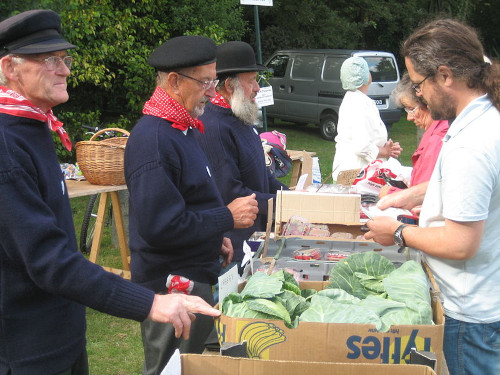 Some traditional garments are so charming and beloved by the locals that they’re still in use today, in the 21st century, even though their design has seen little change throughout the decades or centuries even. A British guernsey is one such piece of folk clothing. A hand-knitted fishermen's sweater became a heritage piece and a symbol of the British knitting industry that developed since the late 1400s. Today, you can often see a guernsey at folk festivals, local celebrations, and other similar occasions in the UK.
Some traditional garments are so charming and beloved by the locals that they’re still in use today, in the 21st century, even though their design has seen little change throughout the decades or centuries even. A British guernsey is one such piece of folk clothing. A hand-knitted fishermen's sweater became a heritage piece and a symbol of the British knitting industry that developed since the late 1400s. Today, you can often see a guernsey at folk festivals, local celebrations, and other similar occasions in the UK.
A gansey or guernsey is a knitted woolen sweater, similar to a jersey, worn by British fishermen. It’s originating from Gansey Island, the Channel Islands. Sometimes, a gansey is also called “knit-frock”. The first use of the name “guernsey” outside of Gansey Island appeared in 1851, but the garment itself existed long before that.
The guernsey, a distinctive knitted garment, has been the cornerstone of Guernsey's knitting industry since the late 15th century. It all began with a royal grant that allowed the import of wool from England and the export of knitted goods to Normandy and Spain. Even during the reign of Charles I, Peter Heylin recorded the manufacturing and export of “waste-cotes”.
Originally, the guernsey was skillfully hand-knitted by fishermen's wives, with the intricate patterns passed down from generation to generation. While today, many guernseys are machine-knit for commercial purposes, the final finishing touches are still done by hand.

Guernseymen selling produce at the Viaer Marchi (Old Market). Photo by LeGroweur from Wikipedia.org
A guernsey is among the most popular garments traditionally worn on the British Isles even today, so it can be considered a part of the local national costume. Its cultural significance was further recognized when a guernsey from the Folk Museum Guernsey was featured in the prestigious 2010 BBC project, A History of the World in 100 Objects.
Additionally, the term “guernsey” can also refer to a similarly-shaped garment made from woven cloth, sometimes called a guernsey shirt or smock. Other regional names for this type of garment include guernsey frock, smock-frock, or fisherman's frock, with the materials used varying based on its intended purpose.
“Working” guernseys and “finer” guernseys
There are two distinct styles of guernseys: the practical “working” guernsey and the more intricate “finer” guernsey, reserved for special occasions and Sunday-best attire. Traditionally, ganseys were seamless and crafted in the round using the circular knitting method.
The “working” guernsey featured a simpler design, aiming to save time and materials during production. Many island families relied on selling knitted garments to supplement their income, so the simplicity of the designs made them more marketable. Completing a guernsey typically took around 84 hours, but simpler designs could be finished faster than more elaborate ones.
Cornwall alone boasts 24 principal patterns, each drawing inspiration from ropes, chains, waves, nets, and sand-prints.
The “finer” guernsey, worn with pride and often hand-knitted by prospective wives to showcase their industrious nature, displayed more intricate patterns compared to its working counterpart. However, with the rise of machine-knitted guernseys and the decline of the knitting industry, this elaborate style has become a rarer sight.
Guernseys, known for their durability, often last for several decades and are cherished heirlooms passed down through families. Guernseys knitted for children were designed to be “grown into” and were often long enough to reach the knee.


